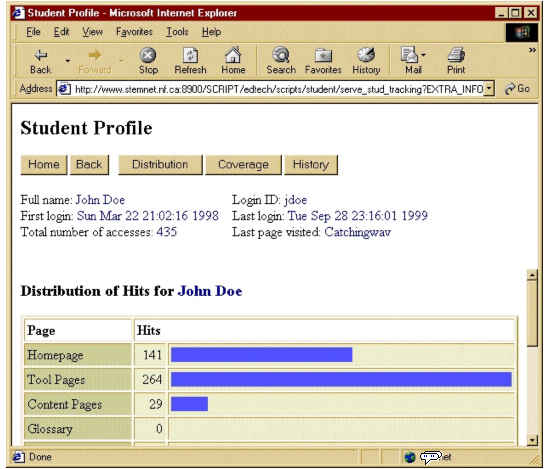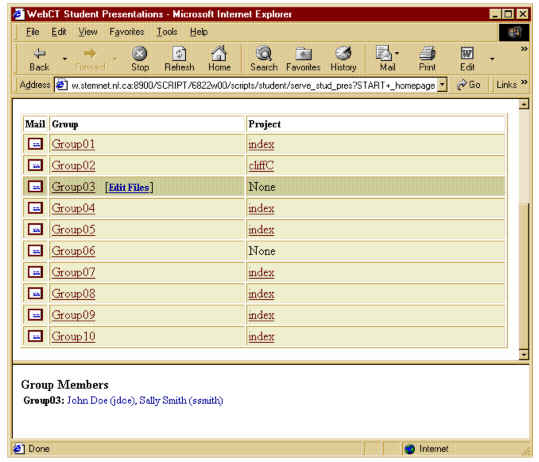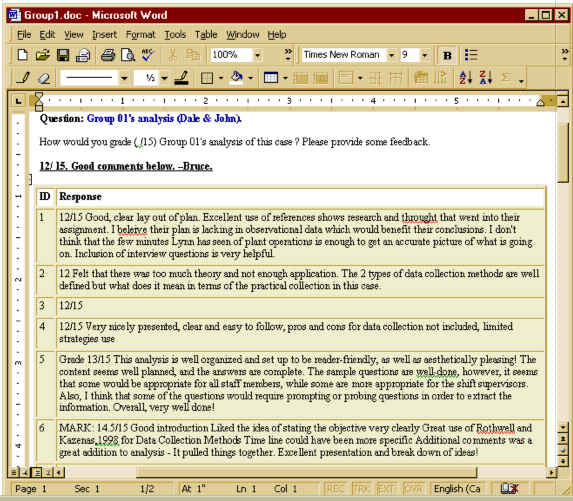
WEBCT: SERVING EDUCATORS IN NEWFOUNDLAND & LABRADOR
Bruce L. Mann
Memorial University of Newfoundland, Faculty of Education
An increasing number of colleges and schools in Newfoundland and Labrador, including some faculty and staff at Memorial University, have joined the list of educators around the world who use WebCT (Web Course Tools) to manage their courses on the Web. WebCT is a computer program written for the Web that facilitates the creation of sophisticated Web-based presentations and environments for collaboration. The content of a WebCT course is provided in HTML pages designed by the instructor or support person.
Internet Communication and the Web
Internet communication first became accessible to educators in the form of a text-based computer program called PARTIcipate in 1981 (see CoNet, 1998), and later CoSy in 1985 (see Softwords, 1995). "World Wide Web" technology was considered to be a major improvement, with its capability of sending graphs and pictures over the Internet. It was over this graphical computer environment that the first Web-supported courses began to appear in 1995. In 1996, the number of online courses available was about 100. In 1998, the number increased close to 1,000, increasing again to 8,000 in 1999, and again to 30,000 courses in 2000. It is estimated that, by 2002, one hundred thousand courses will be available online (McGreal, 2000).
Around the time of the early uses of the Web (in 1995), Computer Science Lecturer Murray Goldberg received funding from the University of British Columbia to develop a system of management tools to facilitate Web course preparation and management. Together with Sasan Salari, Murray developed a product that was so well received by his peers that they launched a WebCT version commercially in 1997. In May 1999, WebCT joined forces with Universal Learning Technology. The combined company expanded rapidly, launching WebCT.com in January 2000. As of July 2000, WebCT had registered 6.7 million student accounts in 147,000 courses at 1480 colleges and universities in 57 countries.
Continuing Education and the STEM~Net
As of this writing, the School of Continuing Education at Memorial University is promoting several Web-supported courses, including: 13 in Business, 13 in Education, 5 in Nursing, 5 in Sociology, 4 Web-supported in Economics, 3 in Psychology, 2 in English, 2 in Social Work, and 1 Web-supported course each in Computer Science, Statistics, Technology, Engineering, Math, Library Studies, and Medicine. The School of Continuing Education has an extensive program of credit courses at Memorial University, as well as many credit-free personal and professional development courses, certificate programs, customized workforce training services, and other services. The Web courses they support are maintained on a computer that is owned by Memorial University.
Several Web courses reside on the STEM~Net computer. In the recent history of WebCT, there have been 29 Web-supported courses in Education, 2 in Psychology, 1 in Group Counselling, and 1 Graduate Research Integrity Program course. STEM~Net (Science, Technology Education and Mathematics Network) is a computer network for K-12 and college educators in Newfoundland and Labrador. STEM~Net, like other computer networks, provides teachers and students with a variety of services including access to electronic mail, libraries, news groups, conferences and the Internet (Mann & Weir, 1993). STEM~Net is currently giving educators in the province two kinds of Web course support, namely: SiteScape or WebCT.
Web-Based Education
Along with presentation and collaboration capabilities, WebCT also purports to facilitate the creation of Web-based educational environments, presumably by non-technical users. WebCT is supposed to enable the development of entire online courses, or simply to publish materials that will supplement existing courses. Results of two studies (Mann, 1998a; 1998b), however, showed that educators with knowledge of instructional design but limited technical knowledge of WebCT needed more technical and design assistance than currently offered in their Web tools and contextualized help. In fact, there are appears to be a consensus in the recent literature (Gros, Elen, Kerres, Merrienboer & Spector, 1997) and in educational organizations around the world that I've visited that Web course instructors and support personnel are really at a loss to know how to match proper methods of course design with contemporary authoring, multimedia and hypermedia systems like WebCT and, when they do, learning principles are omitted or misapplied. Part of the reason for the confusion is that conventional course development methods are based on psychological and educational theory that is too broad in scope and too rigid to prescribe instruction for hypermedia systems like the Web (Tergan, 1998). Conventional methods for developing printed lecture notes or videotaped lectures are frequently too static (Boshier, Mohapi, Moulton, Qayyum, Sadownik, & Wilson, 1997), inert (Yang, Moore & Burton, 1995), unusable (Wild & Quinn, 1998) and -- I would add -- too slow to react, for prescribing satisfactory conditions for Web-supported interactive learning. In short, "instructional design procedures often don't work" (Winn, 1997, p. 36).
Instead of guessing at appropriate design configurations in WebCT, instructors and support personnel seem to adopt personal, stochastic, and somewhat idiosyncratic methods tied directly to their own knowledge and confidence in using WebCT.
Rather than adopt and stay with a particular method, however, these educators seem quite willing to discover, experiment and adapt to new combinations of methods within a certain overall purpose. I call this purpose a "phase", and the discovery method that appears to shift in and out of methods at will, phasing-in- and -out. I believe there are three shifting phases of Web course management, namely: Lesson enhancement, resource-based teaching and learning, and online learning environments. This paper only discusses the first phase of Web course management using WebCT, namely, Lesson enhancement. For a detailed explanation of the phases of Web course management, see Mann (1999a, 1999b or 2000).
Briefly, in the lesson enhancement phase, an instructor approaches the Web with cautious optimism. Usually with help from the resident technologist, the instructor will decide to introduce the Web somehow as an extracurricular activity to enhance the lesson either by setting-up a group discussion, or by requiring student presentations and assessment.
Setting-Up a Discussion
One way in which the instructor initiates WebCT with students to enhance a lesson is to maintain discussion topics in a Computer Conference or Chat Room, monitoring student participation throughout the conference. Figure 1 shows a typical WebCT Bulletin Board collaboration.
Figure 1. Online collaboration using a bulletin board system.

The WebCT conferencing system has a threaded, multi-fora asynchronous electronic conference. Fora can be created and deleted by the instructor. The electronic mail facility can be added to a course allowing one-to-one message transfer among course participants. The interface is very much like that of the bulletin board. The e-mail in WebCT is integrated with the student management and student progress tracking administrative tools. Figure 2 shows a typical online display of student hits.
Figure 2. Online display of student hits using a profiling tool

WebCT can maintain detailed information regarding accesses made by each student in a course. In some cases the designer may wish to allow each student to access the information maintained for him or her. In this way the student would be aware of exactly what information is being recorded about him or her. To facilitate this, WebCT allows the designer to place an icon on a homepage or tool page to permit the student to access this information. Several types of information are provided by here that allow the instructor to monitor student participation and progress.
Online Student Presentations
Another way in which the instructor initiates WebCT with students to enhance a lesson is to get them working online in groups. WebCT supports student groups and allows the designer to designate group membership. As an alternative, WebCT can automatically divide the class into groups given the desired group size. Each group is given a presentation area for the publication of group projects. Group presentation areas are access controlled in that an area can be edited only by group members but can be viewed by any member of the class, as shown below in Figure 3.
Figure 3. Uploaded group assignments with Group 03 highlighted.

Figure 3 shows the list of group assignments of 17 students in a recent graduate course as they were displayed in the WebCT "Presentation" area. Students had collaborated to write a research paper, then "html'd it" and electronically uploaded the html file into their WebCT "Presentations" area. Only group members could edit the content of their group presentation.
Once all the papers are uploaded into WebCT "Presentations", students vote individually on each other's presentation using "Profile" in WebCT. To clarify- "voting" in this sense, means "assigns a mark". The process of assigning a mark occurs as follows: first, individual students view each group's uploaded presentation in WebCT by clicking "Index" in the Project column. Once individual students view each group's uploaded assignment, they assign a mark and justifying comment to each group using the "Survey" tool in WebCT. Similarly, the Instructor assigns a mark and justifying comment to each group using the "Survey" tool. Next, the Instructor concatenates the Instructor and individual student's marks and justifying comments, as shown in Figure 4.
Figure 4. Separate marks and justifying comments displayed for Group 01.

Figure 4 shows the concatenated marks and justifying comments for Group 01, posted separately by the Instructor and the 17 students enrolled in a course in Winter 2000. The Instructor examines the concatenated marks and justifying comments and determines "the final mark and justifying comment" for each Group. The "final mark" is determined from the mid-point between the Instructor's assigned mark and Median mark (average vote) of all 17 students' assigned marks for Group 01. (Based on the data collected from the student in Winter 2000, "the Instructor's" vote will conform in most cases to the Median vote -- average vote of all votes cast by students). Finally, the Instructor pastes the entire results page for Group 01 (including "the final mark and justifying comment") into a word processor, and attaches it to student's email in Group 01. In a few cases, where students cannot read the rtf file, the text is pasted into the email buffer.
Summary
WebCT has been described as a suite of computer-based conferencing tools that facilitate the creation of sophisticated Web-based presentations and collaborations. However, many educators believe that the mere provision of Web management software in no way guarantees critical thinking, that the current status of online collaborative social learning in no way matches the variety of interactions in seminars and tutorials, and that self-paced learning has had a long history of student attrition due to the huge motivational investment required on the part of the student. And although WebCT provides interactivity, structure and the potential for learning to occur, students will always want clear guidelines about how to interact (Janes, 2000).
Since interactivity is a vital component of Web courses, the format for the interaction is of great importance. Although WebCT provides the instructor with greater flexibility for the creation and delivery of the course content, the SiteScape forums are simpler for students (Glassman, 2000, p. 32).
In lieu of better advice than that offered in instructional design principles, instructors and support personnel are employing stochastic methods they deem necessary and sufficient to manage Web courses. Stochastic methods employ a hit-and-miss approach to Web course management that describes student interactions in terms of system tools as a function of system performance. Perhaps over time, we will learn to temper our enthusiasm for system performance with design principles for Web-based learning. Until then, I expect we will continue to phase-in and -out various incantations of curricular Web-based multimedia.
REFERENCES
Boshier, R., Mohapi, M., Moulton, G, Qayyum, A., Sadownik, L., & Wilson, M. (1997). Best and worst dressed web courses: Strutting into the 21st century in comfort and style. Distance Education, 18, 1, 327-349.
CoNet (1998). Background to PARTIcipate. [Available online at
http://fox.co.net/participate/parti.html].
Gibson, S., & Oberg, D. (2000). Learning to teach online: Experiences of two university teachers. In B. L. Mann (Ed.). Perspectives in Web Course Management (pp. 27-34). Toronto, ON: Canadian Scholar's Press.
Goldberg, M. (1997). Communication and Collaboration Tools in WebCT, Proceedings of the Conference Enabling Network-Based Learning, Espoo, Finland. May 28 - 30. [Online at http://homebrew.cs.ubc.ca/webct].
Glassman, M. (2000). Creating a nexus between tele-Learning & tele-Teaching. In B. L. Mann (Ed.). Perspectives in Web Course Management (pp. 239-248). Toronto, ON: Canadian Scholar's Press.
Gros, B., Elen, J., Kerres, M., Merrienboer, & Spector, M. (1997). Instructional design and the authoring of multimedia and hypermedia systems: Does a marriage make sense? Educational Technology.
Janes, D. (2000). International collaborative group interaction: An online experience. In B. L. Mann (Ed.). Perspectives in Web Course Management (pp. 263-276). Toronto, ON: Canadian Scholar's Press.
Mann, B., & Weir, H. (1993). STEM~Net: Who needs it? The Morning Watch: Educational and social analysis, 21(1-2), 30-33.
Mann, B. (1998a). Instructional design for online learning: A case study of WebCT developers. Universities in a Digital Era: Transformation, Innovation and Tradition. Proceedings of The Seventh Annual EDEN Conference University of Bologna, Italy, June 26.
Mann, B. (1998b). Three phases of web-based instructional development. State Conference of The Educational Computing Association of Western Australia, 1998. Notre Dame University. Fremantle, Australia, October 8-9.
Mann, B. (2000). Phase theory: A teleological taxonomy of Web course management (pp. 3-26). In B. L. Mann (Ed.). Perspectives in Web Course Management. Toronto, ON: Canadian Scholar's Press.
Mann, B. (1999a). Web course management in higher education. Bulletin of The Canadian Society for the Study of Higher Education.
Mann, B. (1999b). Web course management. Australian Educational Computing 14(1).
McGreal, R. (2000). Telecampus online course directory. In Bruce L. Mann (Ed.). Perspectives in Web course Management. (pp. 103-115). Toronto, On: Canadian Scholar's Press.
Softwords Research International (1995). What is CoSy? [Available online at http://www.swifty.com/SRI/cosy400/cover.html].
Tergan, S. (1998). Misleading theoretical assumptions in hypertext/hypermedia research. Journal of Educational Multimedia and Hypermedia 6(3/4), 257-283.
WebCT.com (2000). WebCT.com: The Learning Hub. [Aavailable online at http://about.webct.com/prod/index_frameset.htm].
Wild, M., & Quinn, C. (1998) Implications of educational framework for the design on instructional multimedia, British Journal of Educational Technology 29, 1, 73-82.
Wilson, B. (1995). Metaphors for instruction: Why we talk about learning environments. Educational Technology, 35(5), 25-30. . [Also available online at http://www.cudenver.edu/~bwilson].
Winn, W. (1997). Advantages of a theory-based curriculum in instructional technology. Educational Technology. Jan/Feb.
Yang., C., Moore, D., and Burton, J. (1995). Managing lessonware production: An instructional theory with a software engineering approach. Educational Technology Research and Development, 43(4), 60-70.